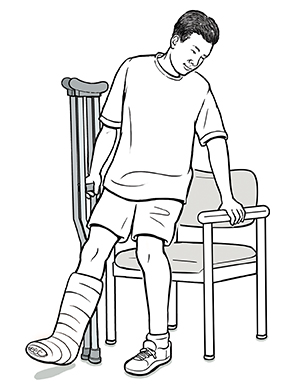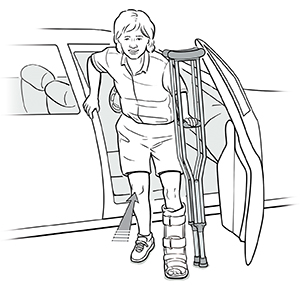These guidelines below will help you get around while on crutches without bearing weight on a healing leg, knee, ankle, or foot. Discuss with your healthcare provider or physical therapist if you have questions or concerns about using crutches safely.
Sitting down
-
Back up until you feel the chair with the back of your leg. Hold both crutches in the hand on your affected side.
-
Grab the armrest or the side of the chair with your free hand.
-
Lower yourself onto the front of the chair, then slide back.
-
To get up, reverse the 3 steps.
Tip
Find sturdy, high-seated chairs with arms. If you must use a chair that swivels or has wheels, back it against something stable before you sit down.
Getting into cars
-
Follow the first step above for sitting in a chair. Use the doorjamb or the dashboard for support as you lower yourself. Watch your head. Don’t hold on to the car door. It may close on you.
-
With your hands, lift your affected leg into the car. Or use your unaffected leg to hook your affected leg behind the ankle and lift it in.
Through doors
-
To push a door open, stand sideways and push the door open with your body.
-
To pull a door open, stand to the side. Get your balance and pull the door fully open with your hand. Plant the tip of the nearest crutch inside the door to act as a doorstop. Leave the crutch in place until you’ve walked through.
Tip
Don't go through revolving doors. Instead, use entrances designed for disabled people.




